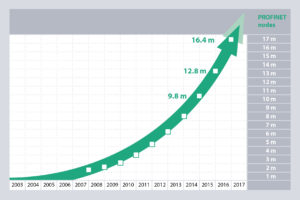The installed base of devices with interfaces of the communication technologies of PROFIBUS & PROFINET International (PI) continues its very strong overall market position. Against the background of Industrie 4.0 incorporation into the automation of production systems, this is a clear sign of the acceptance of PI technologies in this innovative domain.
The development of PROFINET is very encouraging. In 2016, a record 3.6 million PROFINET devices were put into the market. This brought the total number to 16.4 million at the end of 2016, which represents an increase of  28% over the previous year. 2.4 million PROFIBUS devices were produced in 2016, rather fewer than the previous year. However, the total of 56 million devices across all years still represents a record. 10.6 million of these were incorporated into process automation systems. However, if the annual values of the two technologies are compared, PROFINET is significantly ahead of PROFIBUS for the first time. In 2016, 50% more PROFINET devices were produced than PROFIBUS devices.
28% over the previous year. 2.4 million PROFIBUS devices were produced in 2016, rather fewer than the previous year. However, the total of 56 million devices across all years still represents a record. 10.6 million of these were incorporated into process automation systems. However, if the annual values of the two technologies are compared, PROFINET is significantly ahead of PROFIBUS for the first time. In 2016, 50% more PROFINET devices were produced than PROFIBUS devices.
The development of PROFIsafe is still very encouraging: with 1.55 million nodes put into the market, it has been able to achieve above-average growth again of nearly 30% and can now boast 7 million installed nodes. IO-Link in turn experienced the largest increase of 47% over the year in 2016. This brings the total number of installed IO-Link devices to more than 5.3 million.
Karsten Schneider, Chairman of PROFIBUS & PROFINET International (PI), views the figures from the most recent assessment as clear confirmation of the users’ great trust in PI technologies: “Especially against the background of the trends that have become visible through Industrie 4.0, the figures demonstrate impressively that the PI technologies have developed in the right direction. This is motivation for us to continue the work with the same intensity and advance it even further to meet the requirements from the Industrie 4.0 domain. The I40@PI working group founded a year and a half ago has picked up speed. The fundamental requirements stand, and the solutions are taking form in coordination with end users.”
